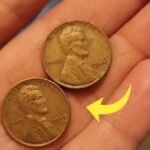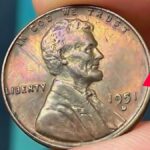The Lincoln Wheat Penny, once just a common coin used daily, has now become one of the most sought-after collectibles in the world. First introduced in 1909, these pennies continued in circulation until 1958. But certain rare versions of them—especially one from 1943—have fetched prices as high as $3 million. While most people ignore these small copper coins, some unknowingly carry a piece of American history that’s worth a fortune.
Lincoln Wheat Penny History and Design
Before 1909, U.S. coins only carried symbolic images, not real people. That changed when the U.S. Mint decided to honor Abraham Lincoln’s 100th birthday. The design was created by Victor David Brenner and featured Lincoln’s profile. This marked the first time a real historical figure appeared on U.S. currency, reflecting a shift in cultural values and a new direction for American coinage.
Wheat Penny Design and Symbolism
The coin’s obverse has Lincoln’s profile with “LIBERTY” on one side and the date on the other, plus “IN GOD WE TRUST” at the top. On the reverse, two wheat stalks curve around the words “ONE CENT” and “UNITED STATES OF AMERICA.” These elements reflect America’s agricultural roots and values of hard work. The wheat design remained unchanged for nearly 50 years, becoming a staple in American pockets.
Why Some Pennies Are Worth Millions
Most Lincoln Wheat Pennies are common, but a few rare ones can be worth millions. Factors include condition, mint mark, historical relevance, and errors. A coin in uncirculated condition with a rare minting mistake becomes a top-tier collectible. The rarest pennies come from years like 1909, 1914, 1922, and 1943, especially when unexpected materials or missing mint marks were involved.
1943 Copper Penny Value and Story
During World War II, the U.S. Mint produced steel pennies to save copper for war needs. However, a few copper planchets from 1942 mistakenly got used in 1943. These rare 1943 copper pennies are now among the most valuable coins in existence. If authentic, one of these can sell from $1 million to $3 million depending on condition and grading. Some are still believed to be in circulation today.
Other Rare Lincoln Penny Variants
The 1909-S VDB is highly valuable for being the first to show the designer’s initials. The 1914-D is rare due to its limited production. The 1922 “Plain” penny lacks a mint mark, making it an oddity. The 1955 Doubled Die version displays a visible error on the front design. Each of these pennies can fetch tens or hundreds of thousands of dollars if preserved in excellent shape.
How to Spot a Rare Penny
Look for key years like 1943, 1909, 1914, or 1922. Use a magnet: steel 1943 pennies will stick, but copper ones will not. The copper penny should weigh about 3.11 grams versus 2.7 grams for steel. Examine color and surface for tone or irregularities. Be cautious of fakes—some are steel coins plated with copper or altered dates. If in doubt, get it checked by a grading service.
Preserving and Grading Pennies
If you suspect you have a rare coin, never clean it or handle it carelessly. Use gloves or hold it by the edges. Store the coin in acid-free holders or slabs. Professional organizations like PCGS, NGC, or ANACS can grade and authenticate your coin. These certifications increase both trust and resale value in the market. Proper handling and grading are crucial for long-term preservation.
How to Start Collecting
Start by checking your change and buying penny rolls from banks. Flea markets, estate sales, and coin shows are other good places to hunt. Beginners should study dates, learn to spot fakes, and understand grading scales. Online guides and collector forums can help build knowledge. Over time, you’ll learn which coins are valuable and which are common, helping you grow your collection smartly.
Modern Market and Accessibility
The internet has opened up the world of coin collecting. Websites like eBay, Heritage Auctions, and GreatCollections let collectors buy, sell, and research rare coins from home. While top-tier Lincoln Pennies sell for thousands or millions, many affordable options remain available. This gives newcomers a chance to participate and possibly stumble upon a hidden gem worth a small fortune.
More Than Money—A Link to History
The Lincoln Wheat Penny is not just about wealth—it connects people with U.S. history. Each coin tells a story of war, industry, and evolving identity. A 1943 copper penny symbolizes wartime urgency. A 1909-S VDB tells of early 20th-century artistry. These coins serve as emotional touchstones for collectors, reminding them of the deep roots behind each simple cent.
Legacy in a Changing World
Even in today’s age of digital payments, these coins continue to hold meaning. While most money now exists in apps or cards, the Lincoln Wheat Penny reminds us of the tangible past. It stands as proof that everyday objects can become priceless over time. For collectors and historians alike, these coins are more than currency—they are symbols of a nation’s journey and transformation.
Disclaimer: The information in this article is for educational and informational purposes only. Coin values are subject to market conditions and authentication. Always consult a certified numismatist or grading service before buying or selling rare coins.






Bakri palan karna he mujhe
Loan
सभी सरकारी यौजना होती तो गरीब के लिये लेकिन इसका लाभ श्रीमंत लोग लाभ लेते है
Comming soon 1.20 lakh
Please 🙏